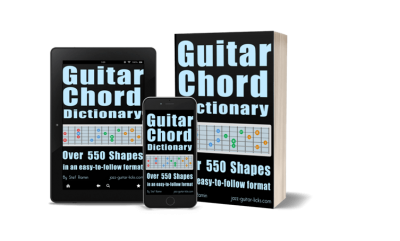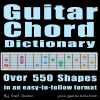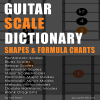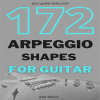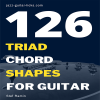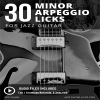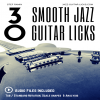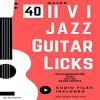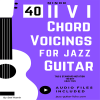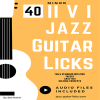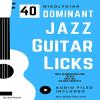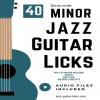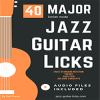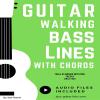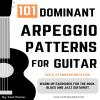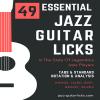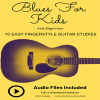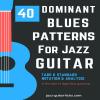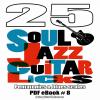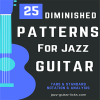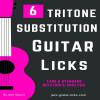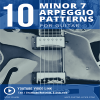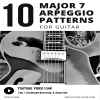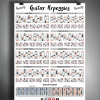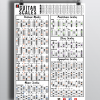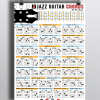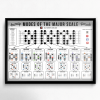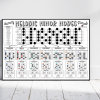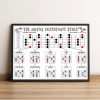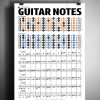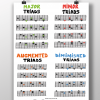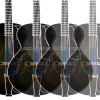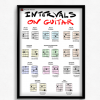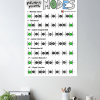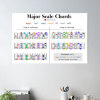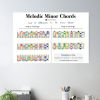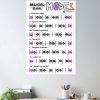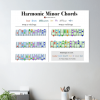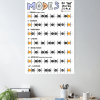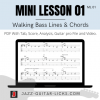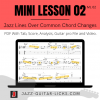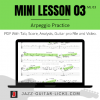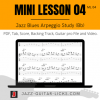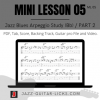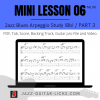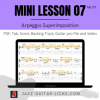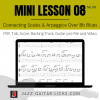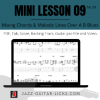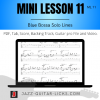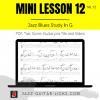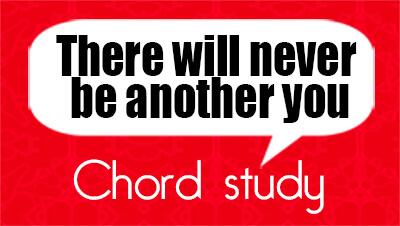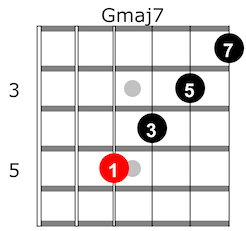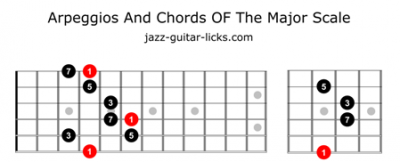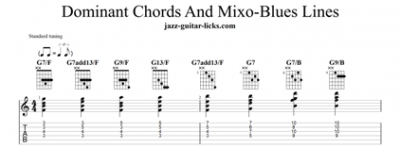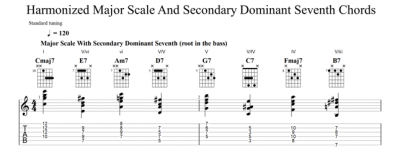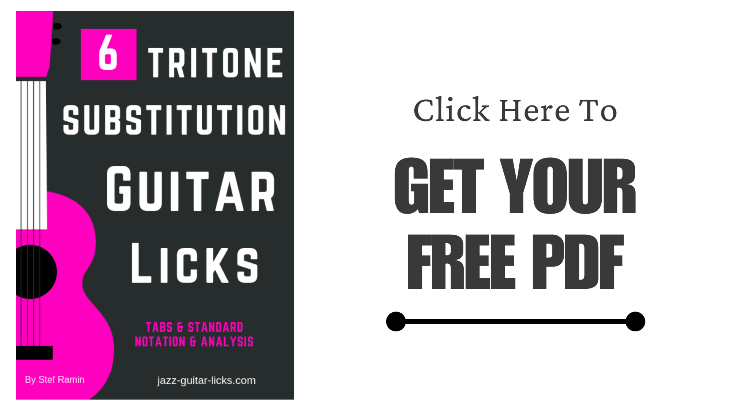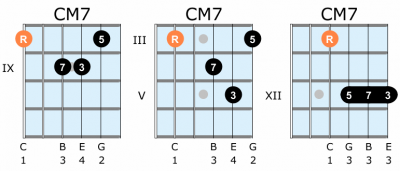
Jazz Guitar Chords For Beginners - Complete Guide
- By jazz-guitar-licks
- On 2020-02-15
- 2 comments
Learning jazz guitar chords is a real challenge for beginners.
In this lesson, you will understand how they are built and how to play them on guitar.
What Are Intervals In Music?
Intervals represent the distance between two notes, they are very important for understanding how chords are built.
All music chords and scales can be considered a combination of intervals.
Here is a quick list of interval names (simple and compound) :
- Second (minor or major).
- Third (minor or major).
- Fourth (perfect or augmented).
- Fifth (diminished, perfect or augmented).
- Sixth (minor or major).
- Seventh (minor or major).
- Octave.
- Ninth ( Compound interval, second + octave) can minor (b9), major (9) or augmented (#9).
- Eleventh (compound interval, fourth + octave). Can be augmented (#11).
- Thirteenth (compound interval, sixth + octave). Can be diminished (b13).
For more detailed information go read the lesson about intervals on guitar.
What Are Jazz Chords?
Basic jazz chords are generally composed of at least four tones that are : root (1 or R), third (minor or major), fifth (diminished or augmented) and seventh (minor, major or diminished).
These types of chords are called "Four Note Chords", "Seventh Chords" or "Tetrads".
They represent the backbone of jazz harmony.
The seventh of the previous voicings can be replaced by the sixth giving other types of chords named "Sixth Chords".
There can be major sixth chords (maj6) built with 1 - 3 - 5 - 6 or minor sixth chords (m6) built with 1 - b3 - 5 and 6.
How To Read Guitar Chord Diagrams?
Guitar chord diagrams are very useful for those who don't know how to read notes on a stave.
They give information on how to place your fingers on the fretboard and shows you what are the notes and the intervals which make up the chord.
They can be presented horizontally or vertically however, it came about, the result is the same.
The three shapes below show three ways of presenting a chord diagram.
Three important information are shown :
- The interval names (1, 3, 5, b7, etc).
- The fingers. (1 for index finger, 2 for middle finger, 3 for ring finger and 4 for pinky finger).
- The note names (A, B, C, D etc).
The orange note is the root note (R) which gives the name of the chord.
This is the most important note it serves to transpose the chord in the key you want or find the name (tonality) of a chord.
The black dots are the other notes of the chord.
- The dots of the figure one (the first from the left) show the intervals, the first line below show the note names and the second line the fingers.
- The dots of the second shape show the fingers to use. The first line below contains the name of the notes and the second line, the intervals.
- In the third diagram the dots correspond to the notes of the chord. The first line below is the fingering and the second line shows the intervals.
How To Transpose Guitar Chords?
Any chord diagram can be played anywhere on the guitar neck, excepted the chords with open strings.
The most easy way to transpose chords that doesn't use open strings is to keep the same position by moving it at the fret you want. Remember that the root (R) gives the tonality of the chord.
Tones And Semitones
This requires to know the placement of the tones (whole-steps) and semitones (half-steps) on the guitar.
Remember that the notes of the diatonic scale are separated by a whole-step excepted E & F and B & C that are a semitone apart. On the guitar, one fret is equal to one semitone so, you need two fret to get a whole-step.
The first diagram below show the semitones (dots in orange) on the guitar neck.
The second and third shapes show the flats (green dots) and sharps (blue dots) between each whole tone.
Transposition
Exemple of chord transposition with C7: When moving the C7 shape down five frets you get a G7 chord.
The root note is at the third fret on the sixth string.
How To Find Different Positions For The Same Chord?
A single chord can be played in various ways, in different locations on the guitar fretboard.
Obviously, the fingering will be different according to the location.
For this, you have to find the root by ear or visually, then the other intervals that make the chord.
The three diagrams below show three chord positions for CMaj7. The first two shapes are built with the same voicing (R - 7 - 3 - 5) however, the position of the second form is a little bit different because of the guitar strings setting.
The notes of the third shape are organized differently giving the voicing R - 5 - 7 - 3.
How To Write Chords?
One of most difficult thing for the novice is to recognize and write jazz chords a jazz standard sheet.
Indeed, the same jazz chords can be written in many ways using different symbols.
Jazz Chord Notation
Jazz players, authors and educators haven't agreed on a common nomenclature for writing chords.
Here is a short list of the most common chord symbols used in jazz standards that will help you identify and write jazz chords :
- MAJOR : C, Cmaj, Cma, CM.
- MINOR : C-, Cmi, Cmin.
- AUGMENTED : CAug, C+
- DIMINISHED : CDim
- SUSPENDE 4 : Csus4, C4.
- MAJOR SEVENTH : CΔ, Cmaj7, Cma7, CM7.
- MINOR SEVENTH : C-7, Cm7, Cmin7.
- DOMINANT 7 : C7.
- HALF-DIMINISHED : Cm7b5, Cø.
- DIMINISHED SEVENTH : Cdim, Cdim7, Cº7.
- AUGMENTED SEVENTH : C7+, C7aug, C7#5.
- MINOR MAJOR SEVENTH : CminMaj7, Cmin(Maj7), CmiΔ, C-Δ.
- DOMINANT SEVENTH SUSPENDED FOURTH : C7sus4, C7sus.
Chord Extensions
Basic chords can be extended with extra notes as 9, 11, 13. Remember that : the seconds are the same as ninths, the fourths are the same as elevenths and the sixths are the same as thirteenths.
Exemple in the key of C :
- D is the second and the ninth of C.
- F the fourth is the octave of the eleventh of C.
- A is the sixth and the eleventh of C.
Here is a short list of extensions applied to common jazz chords.
- MAJOR SEVENTH EXTENSIONS : 9, 11, 13. (Cmaj9, Cmaj11, Cmaj13).
- MINOR SEVENTH : 9, 11, 13 (Cm9, Cm11, Cm13).
- DOMINANT SEVENTH : 7, 11, 13. (Dom9, Dom11, Dom13).
Chord Alterations
The 5, 9, 11 and 13 of minor 7 , major 7 and dominant 7 chords can be altered with a flat (b) and a sharp (#) giving this kind of notation :
- 7#9, 7#11, 7b13, 7b9, 7b5, 7b9b13 for dominant chords.
- Maj7#11, Maj7#5 for major seventh chords.
Minor seventh chords are rarely altered.
Chord Symbols
- Δ (triangle) Means major seventh.
- A (7) means that the 7th of a maj7 chord is lowered with one semitone making a dominant 7 chord.
- A dash (-) means that the third and the seventh are lowered, giving a minor seventh chord.
- The crossed circel ( ø) means half-diminished.
- The circle (°) means diminished.
- The plus (+) means augmented. It can be placed after the 7 of a dominant chord meaning that the fifth is augmented with a half-step. e.g C7+.
- The sharp (#) is placed before the extension of a seventh chord. e.g : C7#9, C7#11, CMaj7#11. It means that the 9 or the 11 are raised with one semitone.
- The flat (b) is written befor the extension. e.g : C7b9, C7b13, C7b5b9. Meaning that the extra note is lowered with a half-step.
Slash Chords
Slash chords are chords with non-root note in the bass.
They can be seen as inverted chords. Exemple with Am/C. This is an Am chord (A - C - E) with the third (C) in the bass.
The root note is no longer the bass note.
The first letter on the left the slash (A), indicates the tonality of the original chord.
The second letter on the right of the slash (C) shows the bass note.
Basic Guitar Chord Shapes
The following provides the basic guitar chord diagrams and voicings of the most common types of chords found in jazz standards and progressions.
Be sure to memorize them and try to play them in all twelve keys everywhere on the guitar neck.
Remember that all the chord shapes below are movable all along the guitar neck.
Notice that these basic voicings do not have a strong jazz sound, they just represent a solid basis for jazz beginners.
Major Seventh Chords
Let's start with major seventh chords built with root (1) - third (3) - fifth (5) and seventh (7).
They are related to the I and IV chord of the harmonized diatonic major scale.
- The first figure is drop 3 voiced (R 7 3 5).
- The two other shapes are drop 2 voicings (R 5 7 3). Notice that the fifth is doubled in the second diagram, you can choose to play only one fifth if you want.
Minor Seventh Chords
Minor seventh chords are built with Root (R) - minor third (b3) - fifth (5) and minor seventh (b7).
They are related to the degrees II, III and IV of the major diatonic scale.
The voicings used in the following shapes are the same as the previous Maj7.
Dominant Seventh Chords
Dom7 chords are made of Root (R) - major third (3) - fifth (5) and minor seventh (b7).
They are related to the V degree of the major scale, the melodic minor scale and the harmonic minor scale.
They are used in many jazz progressions, often extended and sometimes altered to bring a little bit of tension jazz lines and comping.
Once again the voicings used are R b7 3 5 for the first shape and R 5 b7 3 for the two others.
Half-diminished Chords
Half-diminished chords are minor chords whith the fifth lowered thus giving the formula Root (R) - minor third (b3) - diminished fifht (b5) and minor seventh (b7).
They are related to the VII degree of the major scale, but mostly associated with the degree II of the harmonic minor scale so, they are found in minor 2 5 1 chords progressions.
Diminished Seventh Chords
The interval pattern for diminished seventh chords is Root (R) - minor third (b3) - diminished fifht (b5) and diminished seventh (bb7).
Dim7 chords are not very used in jazz harmony, but they can serve as substitutions for 7b9 chords in turnarounds or minor II V I sequences.
Diminished 7 chords most striking feature is that they are symmetrical, you can play the same chord position every three frets (3 semitones apart).
Extended Jazz Guitar Chord Charts
Extended chords are chords embellished with one or several notes located above the octave of the root note.
These extensions are the ninth (9), eleventh (11) and thirteenth (13).
They can be applied to minor and major triads but also to minor seventh, major seventh and dominant seventh chords thus giving some of the following chord voicing shapes.
Minor Ninth Chords
Minor ninth chords are built with Root (R) - minor third (b3) - fifth (5), minor seventh (b7) and ninth (9).
They can be seen as minor seventh chords with an added ninth.
Due to the difficulty playing all the chords tones, in some cases the fifth can be removed, this way you'll play the most important notes of the chord that are 1 - b3 - b7 and 9.
Major Ninth Chords
The interval pattern for major ninth chords is Root (R) - third (3) - fifth (5), seventh (7) and ninth (9).
They can replace any major seventh chord, depending on the musical context. Once again the fifth is omitted.
Dominant Ninth Chords
Dominant ninth chords are dom7 chords with an extra note, the ninth. Giving the theoretical formula Root (R) - major third (3) - fifth (5) and minor seventh (b7) and ninth (9).
They can be used to enrich the V7 chord of any diatonic progression. Here are the most basic voicing shapes.
Minor Eleventh Chords
Minor Eleventh chord formula is Root (R) - minor third (b3) - fifth (5), minor seventh (b7) ninth (9) and eleventh (11).
Here are the two main shapes to play them on guitar.
Dominant Eleventh Chords
Dominant 11 chords are spelled Root (R) - third (3) - fifth (5), minor seventh (b7), ninth (9) and eleventh.
They should not be confused with 7sus4 chords that are built with 1 - 4 - 5 - b7.
Here are three common guitar diagrams.
Minor Thirteenth Chords
Minor thirteenth chords are theoretically made of seven tones giving the formula Root (R) - minor third (b3) - fifth (5), minor seventh (b7), ninth (9), eleventh (11) and thirteenth (13).
Once again it is physically difficult to play movable min13 chord shapes on guitar.
So, only the important notes are kept in the following forms.
Major Thirteenth Chords
Major 13 chords are major 7 chords with three added notes above the root octave. The formula is Root (R) - major third (3) - fifth (5), seventh (7), ninth (9), eleventh and thirteenth.
Due to the lack of the ninth and the eleventh in the first two shapes, the chords should be named Cmaj7add13. Prefix "add" means that only the 13 is added to the chord.
Dominant Thirteenth Chords
The interval pattern for Dom13 chords is Root (R) - major third (3) - fifth (5), minor seventh (b7), ninth (9), eleventh (11) and thirteenth (13).
Here are the two most common chord shapes.
They can embellish any diatonic V7 chord.
Altered Guitar Chord Shapes
Altered guitar chords are chords that have one or more notes altered (lowered or raised) by a semitone (a half-step).
The notes altered are the fifth (b5), the ninth (b9 / #9), the eleventh (#11) and the thirteenth (b13).
These altered tones are mostly applied to dominant chord giving some chords with long strange and strange names as 7#9, 7b9, 7b9b13, 7#11 and many others.
Altered chords can be a bit out and sound wrong for jazz beginners but they are very useful to add color / tension to jazz chord progressions.
It sometimes takes a while to hear and tame them.
Here are some shapes related to the most used altered chords in jazz music.
Jazz Guitar Chord Exercises
The first way of practicing jazz guitar chords when you want to make the difference between them is to play each chord type starting on the same root and on the same string.
Here are three exercises :
Chord Practice - Exercise 1
As you see in the tabs below the five main types of chord are played one after the other in a logical way in order so that you have to change only one note at a time.
The order of the chords is Maj7, Dom7, Min7, m7b5 and dim7.
The root notes are on the sixth string.
Chord Practice - Exercise 2
In the following example the chords have roots on the fifth string.
Chord Practice - Exercise 3
Now the root notes are on the fourth string.
Exercise 4 - Major 2 - 5 - 1 - Jazz Guitar Comping
Here is a serie of three major II V I patterns including some previous basic chord shapes from this lesson.
Once you have learned these chord changes, be sure to practice them in twelve keys by varying the rhythm.
The first example is a 2 5 1 chord progression in C major containing three chords :
- Dmin7 as the ii chord.
- G7 as the V chord.
- Cmaj7 as the I chord.
Exercise 5 - Major 2 - 5 - 1 Progression - Jazz Guitar Comping
This second 2 5 1 example is still in the key of C. Here we find the same chords but in other positions.
Notice that the last chord is a C6/9 chord (pronounced C sixth / ninth).
It's a great chord that sounds very well, it is very used in place of maj7 chords.
Exercise 6 - Major 2 - 5 - 1 Sequence - Jazz Guitar Rhythm
This third and last major II V I comping pattern is made of Dmin7 (root on the 4th string), G7 (root on the 5th string) and Cmaj7 (root on the 4th string).
Exercise 7 - Minor 2 - 5 - 1 Sequence - Jazz Guitar Comping
Here is a first exercise to start off a serie of three minor 2 5 1 chord exercises.
In minor key the I chord is a half-diminished chord (m7b5), the V chord is dominant 7th chord that can be extended with a b9 or a b13 (as shown in the tab below).
Theoretically, the minor I chord should be minMaj7, however it is generally replaced by a basic min7 chord.
Exercise 8 - Minor 2 - 5 - 1 Sequence - Jazz Guitar Comping
You can hear at the end of this minor 2 5 1 pattern how the min7 chord can be enriched with the ninth (9).
Exercise 9 - Minor 2 - 5 - 1 Sequence - Jazz Guitar Comping
Lastly, here is another minor II V I sequence using a Cmin6 chord alternating with Cmin7.
Jazz Guitar Comping - Chord Studies
Here we are at the most interesting part of the lesson. So it's time to apply some chord shapes previously seen to popular jazz chord changes and standards.
Jazz Blues Walking Bass Study
The first study is a jazz blues progression in A mixing basic chords and walking bass lines.
Let's take a look at the chords used. The first five bars imply two dominant chords that are A7 and D9.
In the sixth bar you hear a diminished passing chord (Ebdim7).
This kind of chord is fairly common to make the link between the IV7 and I7 chord.
In measures 8, 9 and 10 there is a 6, 2, 5, 1 sequence (F#m7 - B9 - E7 - A7).
The same sequence is repeated twice but with two chords per/measure.
Notice that the last two chords (B7b13 - E7#9) are altered.
All of Me - Jazz Guitar Chords
All of me is a very famous jazz standard written by Simon & Marks in 1931, one of the most played in gigs.
It's an AB form where each section contains 16 bars.
All of Me structure can also be seen as an AA' form where the second A (prime) is actually a variation of the first A.
The melody and the chords are quite easy to play, that's the reason why many jazz guitar beginners appreciate this tune.
Here is an easy chord arrangement containing some of the easy shapes provided in this lesson.
Many types of chords are represented as Maj7, Maj6, Dom7, 7b9, 7b5, min7, slashed chords, min6, min9, min11, min6, Maj7add13, dom13, 7b13, 6 and dim7.
The rhythm has been intentionally simplified to work better as a tutorial, so don't hesitate to improve it.
-
Guitar Chord Dictionary
This PDF eBook provides over 550 guitar chord shapes. This is the perfect reference guide to understand how chords are built and how to play them on the guitar neck. -
Guitar Scale Dictionary
This E-book is a printable PDF method including over 700 scale diagrams and formula charts for guitarists. -
Harmonized Scales For Guitar
Complete guitar PDF on harmonized scales: major, minor, harmonic and melodic. Includes chord and arpeggio diagrams, charts and practical tabs. -
172 Arpeggio Shapes For Guitar
This printable PDF is a method dedicated to guitarists of all styles who want to learn build and play the most important types of arpeggios. -
126 Triad Chord Shapes
This handbook for guitar players is intended both for teachers and students. It includes 126 guitar shapes for mastering triads. -
Harmonic Major Scale Chords
this PDF offers diagrams and tabs for guitar to learn the chords of the harmonic major scale. -
Major Scale Harmonization
This package provides a printable PDF with exercises and audio files to learn how to harmonize the major scale with 3 note chords and their extensions. -
30 Minor Arpeggio Licks
This package includes a printable PDF method containing 30 exercises with tabs, staves and audio files for practicing minor arpeggios on guitar. -
II V I Bundle - 170 Exercises
This bundle contains 4 PDF methods for a total of 170 exercises with tabs, staves, analysis & audio files for practicing scales, arpeggios licks & chords over the 2-5-1 progression. -
Diatonic Licks Bundle
This package contains 120 jazz guitar lines based on diatonic modes as Mixolydian, Dorian and Ionian. PDF format with tabs, audio files and analysis. -
30 Groovy Jazz Guitar Licks
This downloadable package contains a PDF WITH audio files giving access to 30 groovy guitar phrases mixing jazz, blues and funky licks for beginners. -
30 Smooth Jazz Guitar Licks
In this package you'll get a printable PDF Method with tabs, notation, analysis, scale shapes and audio files for practicing 30 smooth jazz guitar licks. -
40 II V I Jazz Guitar Licks
This pdf method for guitar contains fourteen 2 5 1 jazz guitar lines with tab, standard notation, analysis, scale charts and audio files. -
50 II-V-I voicings
This printable PDF guitar method provides 50 exercises with audio files, analysis, tab and staves for learning major 2-5-1 chord voicings. -
40 Minor 2 5 1 Chord Voicings
This PDF method contains 40 exercices with tabs, scores and audio files for practicing jazz guitar chords over the minor 2 5 1 progression. -
40 Minor II V I Licks
This guitar method is a printable PDF with tabs, diagrams, theory and audio files providing 40 minor 2 5 1 jazz patterns. -
40 Mixolydian Jazz Guitar Lick
PDF guitar method with tabs, audio files and theory providing 40 dominant jazz guitar lines for teachers and students. -
40 Minor Jazz Guitar Licks
This printable guitar method in PDF format contains 40 easy minor jazz guitar lines based on the Dorian mode. -
40 Major Jazz Guitar Licks
Printable PDF eBook method containing 40 major jazz guitar licks with tab, standard notation and audio files for beginners and intermediates. -
Guitar Walking Bass Lines
This jazz guitar method about walking bass lines and chords is available as a PDF files containing 35 exercises with tabs, analysis and audio files -
101 Dominant Arpeggio Patterns
This printable PDF method provides 101 dominant arpeggio exercises with tab, theory and standard notation for the jazz, blues and rock guitarist. -
49 Essential Jazz Lines
This printable eBook method in PDF format provides 49 jazz solo transcriptions of the greatest jazz musicians. Tab, standard notation, audio files & analysis. -
11 Jazz Blues Studies
11 jazz blues chord studies with tabs, standard notation, analysis, and audio recordings and PDF. -
10 Easy Fingerstyle Blues
This PDF with Tabs and audio files provides 10 easy acoustic fingerstyle blues guitar studies for kids and beginners. -
25 Altered Jazz Guitar Lines
This PDF eBook method contains 25 altered jazz guitar licks with tabs, patterns, scale charts and audio files to master, apply and develop the altered scale. -
40 Blues Dominant Patterns
This printable method is available as a PDF file containing 40 easy dominant jazz-blues guitar lines with tabs, standard notation, analysis, audio files and scale charts. -
25 Pentatonic Licks
This jazz guitar method is an eBook available as a PDF with standard notation, guitar tabs, diagrams, analysis, audio files and backing tracks. You will find in this booklet 25 easy jazz guitar lines with theory using common and rare pentatonic scales. -
25 Soul Jazz Guitar Licks
You will find here an eBook available in PDF containing 25 soul jazz and hard bop guitar licks in the style of Grant Green, Melvin Sparks, George Benson. -
25 Diminished Patterns
This eBook PDF with audio files contains 25 dominant diminished jazz guitar patterns using the half-whole diminished scale and diminished 7th arpeggios. -
6 Tritone substitution licks
This Printable PDF eBook available for free download contains 6 easy jazz guitar licks with tabs/notation, youtube video link and analysis about the tritone substitution. -
10 Minor 7 Arpeggio Patterns
This printable PDF eBook offers 10 easy minor 7 arpeggio patterns with its related YouTube video for beginner guitarists. -
10 Easy Major 7 Arpeggio Licks
This is a printable PDF for beginner jazz guitar players providing 10 easy licks to practice major 7 arpeggios. -
10 Chord Melody Lines
Within this package, you'll discover a set of ten chord melody exercises for beginners. Printable PDFaudio files, a backing track, and a link to the associated YouTube video. -
10 Minor Blues Scale Licks
You'll find here a PDF with 10 easy jazz guitar licks to practice the minor blues scale on guitar.
-
Guitar Arpeggios Poster
This giant guitar poster for any guitar player, student or instructor contains colorful arpeggio diagrams. Giant size 24 x 36 inches (60 x 90 cm). -
Guitar Scales Poster 24*36
Guitar posters and wall art with eighteen neck diagrams representing the most used scales in music. -
Guitar Chord Poster
This printed color posters contains 63 guitar chord diagrams for jazz players, students, teachers and schools. -
Guitar Modes Poster
Guitar reference posters and wall art about modes of the major scale for guitar teachers, students and music schools. -
Melodic Minor Modes Poster
Educative and decorative giant guitar poster with neck diagrams, interval names about the seven modes of the melodic minor scale. -
Pentatonic Scale Guitar Poster
This guitar reference poster shows the positions and intervals of the major pentatonic scale. -
Guitar Notes Poster
This is a giant poster showing the notes on the guitar fret board and their positions on a musical staff. -
Triads Guitar Poster
This reference poster show the positions and intervals of the main triads used on guitar. This is a useful tool for guitarists, teacher and students. -
Four Archtop Guitars Poster
This is a decorative poster with four archtop jazz guitars. Several size and colors in landscape format available on Teespring and redbubble. -
Intervals On Guitar - Poster
This giant poster for guitar provides neck diagrams with interval positions. -
Melodic Minor Modes
This music theory poster available in several sizes shows the construction of the seven modes of the melodic minor scale. -
Major Scale Chords
This handy poster provides a clear visual guide to the chords built from the major scale, helping you recognize patterns and improve your playing. -
Melodic Minor Chords
Explore the rich harmonic possibilities of the melodic minor scale with this essential guitar poster. -
Harmonic Minor Modes
This music theory poster, offered in various sizes, demonstrates the structure of the seven modes of the melodic minor scale. -
Harmonic Minor Chords
Discover the chords of the harmonic minor scale with this guitar poster. -
Major Scale Modes
This poster is created for music teachers and students, illustrating the structure of the seven modes of the major scale.
-
Mini Lesson 01 (ML 01)
You'll find a mini guitar lesson about walking bass lines and chords containing a PDF with tab, score analysis, shapes, a video and a guitar pro file. -
Mini Lesson 02 (ML 02)
In this mini jazz guitar lesson you will learn how to play easy and cool jazz lines over basic chord changes found in jazz. Pdf, tab and video included. -
Mini Lesson 03 (ML 03)
With this short lesson you will learn how to play and connect basic guitar arpeggios over a diatonic chord progression. -
Mini Lesson 04 (ML 04)
This is a downloadable package with PDF, Tab, guitar pro file and video to practice guitar arpeggios over a jazz blues chord progression. -
Mini Lesson 05 (ML 05)
This downloadable package provides a PDF with Tab/score, a guitar pro file and a short video for practicing guitar arpeggios on a jazz blues progression in Bb. -
Mini Lesson 06 (ML 06)
This package for guitarists contains a PDF with tab, video, backing track and guitar pro file for practicing arpeggios over a basic jazz blues progression. -
Mini Lesson 07 (ML 07)
With this mini guitar lesson you will learn how to superimpose arpeggios over a diatonic chord progression. Video, pdf, jamtrack and guitar pro file included. -
Mini Lesson 08 (ML08)
Mini lesson with PDF, guitar pro file, video and backing track for practicing scale and arpeggio connections over a Bb jazz blues progression. -
Mini Lesson 09 (ML09)
This mini lesson is a downloadable package containing a PDF, video, backing track and guitar pro file of a jazz blues progression study in B. -
Mini Lesson 10 (ML 10)
This mini guitar lesson provides a printable PDF with tab/notation, video, backing track and guitar pro file for practicing open triads over Fly Me To The Moon. -
Mini Lesson 11 (ML 11)
This guitar lesson is a package inlcuding a PDF transcription with analysis, a short video, a backing track and a guitar pro file to learn to play jazz solo lines over Blue Bossa. -
Jazz Blues Guitar Study (ML12)
This mini lesson provides a video, a guitar pro file and PDF transcription of a jazz blues study in G implying melodic lines, chord extensions and substitutions
guitar chords chord shapes jazz voicings guitar comping jazz guitar chords for dummies jazz guitar chords for beginners guitar chord diagrams chord construction
Comments
-

- 1. Alex johnasson On 2024-12-21
Awesome guide. Is the PDF covers the same chords?
Thanks-
- jazz-guitar-licksOn 2024-12-21
Hello, Thanks. The PDF provides another approach with more chords. Stef
Add a comment
